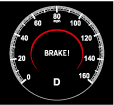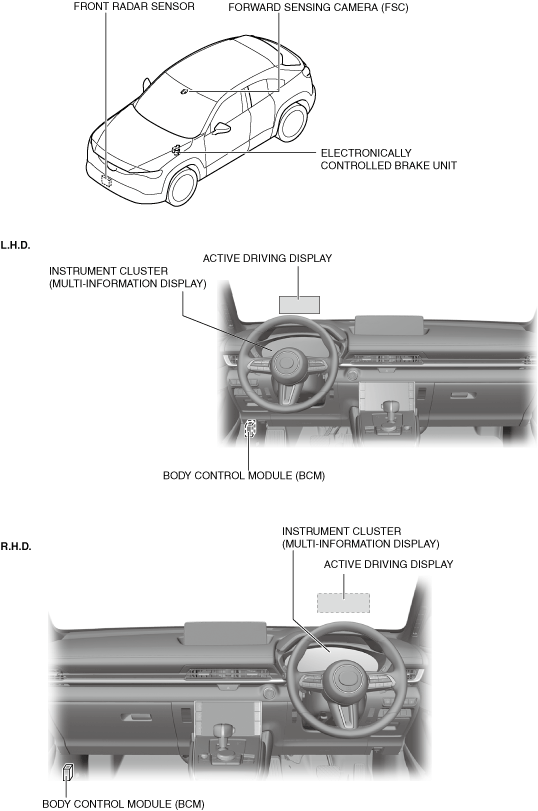SMART BRAKE SUPPORT (SBS) [TURN-ACROSS TRAFFIC]
id151000015100
Outline
• If the possibility of a collision with a vehicle approaching in the opposite direction increases due to the driver not confirming the safety while turning the vehicle at an intersection, the smart brake support (SBS) [turn-across traffic] performs brake control to reduce the damage in the event of a collision.
-
Caution
-
• Tires for all four wheels must always be of the specified type and size. If tires other than the specified type and size are used, the smart brake support [turn-across traffic] may not operate normally.
• Do not mix tire types or use tires with significantly different wear patterns on the same vehicle. Use of inappropriate tires could result in the DSC and the smart brake support [turn-across traffic] not operating normally.
-
Note
-
• The smart brake support [turn-across traffic] is designed to assist the driver. The driver's driving operation always takes priority even while the smart brake support [turn-across traffic] is operating. For this reason, if the driver operates the accelerator pedal to avoid danger, the smart brake support [turn-across traffic] operation is canceled.
• When inspecting the vehicle using a chassis dynamometer, turn off the smart brake support [turn-across traffic] using the personalization features to prevent incorrect operation of the smart brake support [turn-across traffic].
• The smart brake support [turn-across traffic] can be changed between operational and non-operational using the personalization features. For details on personalization features, refer to [PERSONALIZATION FEATURES] in the workshop manual.
Construction
• The smart brake support [turn-across traffic] uses the front radar sensors installed to the front bumper and the forward sensing camera (FSC).
• The front radar sensor installed to the front bumper and the forward sensing camera (FSC) detect vehicles approaching in the opposite direction.
Function
Brake control
-
• When the body control module (BCM) determines that there is the possibility of a collision with a vehicle approaching in the opposite direction based on target information from the front radar sensor and the forward sensing camera (FSC) when the vehicle is accelerating from a stop to make a left turn. Then, if the driver does not perform an avoidance maneuver and it determines that a possible collision has increased, it outputs a brake control (damage reduction braking) request signal to the electronically controlled brake unit to operate the brake control (damage reduction braking).
-
― Brake control (damage reduction braking)
-
• If the body control module (BCM) determines that there is the possibility of a collision with a vehicle approaching in the opposite direction when the vehicle is accelerating from a stop to make a left turn, it warns the driver using a warning sound (smart brake support [turn-across traffic]) and the indications on the active driving display and the multi-information display and, at the same time, the electronically controlled brake unit operates the brake control (damage reduction braking) which applies the brakes on all four wheels.
-
Warning
-
• The smart brake support [turn-across traffic] operates when certain conditions are met, however, it is not a system that assures prevention of a collision.
• There are limitations to the brake control (damage reduction braking). Always keep a safe distance from the vehicle approaching in the opposite direction or obstruction and depress the brake pedal appropriately while verifying the safety of the surrounding area.
Smart brake support [turn-across traffic] display function
• The smart brake support [turn-across traffic] notifies the driver of the system status using the active driving display and the multi-information display.
Smart brake support [turn-across traffic] display function table
|
Status
|
Smart Brake Support (SBS) OFF indicator light
|
i-ACTIVSENSE warning light
|
Active driving display
|
Multi-information display
|
|
Smart brake support [turn-across traffic] is off
(Main power is switched ON (READY off or on)
|
Smart brake support [turn-across traffic] is stopped
|
On
|
Off
|
No display
|
No display
|
|
During smart brake support [turn-across traffic]
|
Possibility of collision with vehicle approaching in opposite direction
|
Off
|
Off
|
 |
 |
|
Approx. 2 s have elapsed since vehicle was stopped by brake control (damage reduction braking) operation
|
Driver depresses brake pedal
|
Off
|
Off
|
No display
|
No display
|
|
Driver does not depress brake pedal
|
Off
|
Off
|
No display
|
No display
|
|
Smart brake support [turn-across traffic] malfunction occurs
|
Smart brake support [turn-across traffic] malfunction
|
On
|
On
|
No display
|
 |
|
Smart brake support [turn-across traffic] function is stopped temporarily
|
Due to sensor
|
On
|
On
|
No display
|
 |
|
Due to other cause
|
On
|
Off
|
No display
|
No display
|
-
Caution
-
• If a DTC is stored in the body control module (BCM) by the on-board diagnostic function, the smart brake support [turn-across traffic] is inhibited depending on the cause of the malfunction.
• If DTCs are stored in the electronically controlled brake unit, front radar sensor, forward sensing camera (FSC), PCM, or the instrument cluster, the smart brake support [turn-across traffic] may be inhibited depending on the cause of the malfunction.
-
Note
-
• With the smart brake support (SBS) system turned off, the smart brake support [turn-across traffic] is also turned off.
System wiring diagram
Block diagram
Operation
• When all of the following conditions are met, operation of the brake control (damage reduction braking) is allowed, and it operates if the possibility of a collision with a vehicle approaching in the opposite direction increases.
-
― Switch the main power ON (READY off or on)
― Smart brake support (SBS) is not stopped
― Detecting vehicle speed is approx. 4 km/h {2.5mph} or more, approx. 20 km/h {12 mph} or less
― Speed of vehicle approaching in opposite direction is approx. 25 km/h {16 mph} or more, approx. 60 km/h {37 mph} or less
― No abnormality in DSC system
― No abnormality in a front radar sensor and the forward sensing camera (FSC)
― No major malfunction related to other vehicle behavior
― Turn light (LH) is flashing(L.H.D)/Turn light (RH) is flashing(R.H.D)
― Forward sensing camera (FSC) recognizes center line between detecting vehicle and vehicle approaching in opposite direction
-
Note
-
• The smart brake support [turn-across traffic] operates even if the DSC operation is inhibited by operating the DSC OFF switch, and the DSC OFF indicator light is turned on. If the smart brake support [turn-across traffic] operates while the DSC has been inhibited, the DSC transitions to permit status and the DSC OFF indicator light turns off.
• If ice, snow, or dirt is adhering to a front radar sensor or the forward sensing camera (FSC), it may not detect normally. As a result, the smart brake support [turn-across traffic] may not operate normally.
• A front radar sensor and the forward sensing camera (FSC) may not detect normally depending on the travel or vehicle conditions. As a result, the smart brake support [turn-across traffic] may not operate normally.
• A front radar sensor and the forward sensing camera (FSC) may not detect depending on the position of a surrounding obstruction, its shape, or its material. As a result, the smart brake support [turn-across traffic] may not operate normally.
Brake control (damage reduction braking) operation
Solenoid valve operation table
|
Pressure feed valve
|
TMC cut valve
|
Inlet solenoid valve
|
Outlet solenoid valve
|
Simulator valve
|
Linear actuator
|
|
LF―RR
|
RF―LR
|
LF―RR
|
RF―LR
|
LF
|
RF
|
LR
|
RR
|
LF
|
RF
|
LR
|
RR
|
|
ON (open)
|
ON (closed)
|
OFF (open)
|
OFF (closed)
|
ON (open)
|
Operation
|
Hydraulic circuit diagram
-
• If the driver does not perform an avoidance maneuver and there is the possibility of a collision based on target information (1), the body control module (BCM) sends a brake control (damage reduction braking) request signal (2) to the electronically controlled brake unit. At the same time, the body control module (BCM) outputs a warning sound signal (2) to the notification and warning speaker (front) to activate the warning sound.
• When the electronically controlled brake unit receives the brake control (damage reduction braking) request signal (2), it energizes the linear control solenoid valve, switches the hydraulic circuits, and increases the brake fluid pressure. As a result, the brake control (damage reduction braking) operates (3).
• While the brake control (damage reduction braking) is operating, a brake light signal (3) from the electronically controlled brake unit is sent to the electrical supply unit (ESU) at the same time. The electrical supply unit (ESU) which receives the signal turns the brake lights on (4).
• A brake light status signal (4) is output from the electrical supply unit (ESU) to the electronically controlled brake unit at the same time as the brake lights are turned on.
• While the brake control (damage reduction braking) is operating, a message is displayed on the active driving display and multi-information display.
• If the body control module (BCM) determines that there is no possibility of a collision based on the target information (1), the brake control (damage reduction braking) operation is canceled.




